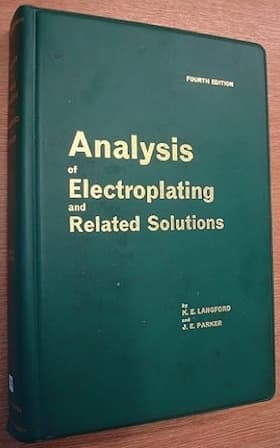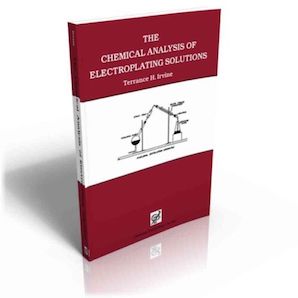
-----
Cyanide in Waste Water Test
Cyanide analyses, especially total cyanide analyses, are notoriously unreliable: split samples have been measured & recorded by certified laboratories with such wide discrepancies so many times that the analysis borders on just being silly.
Q. I have a client that has a copper cyanide strike tank located after acid activation (HCL) and prior to a nickel/chrome finish.
The counter flow rinse waters from the copper cyanide tank is directed to a 1st stage flow-through cyanide treatment tank at a maximum of 0.5 gallons per minute and has a retention time of several days. Mixing is performed continuously at the entrance of this tank. Once per day an operator adds approximately 0.5 gallons of bleach ⇦ bleach/sodium hypochlorite in bulk on eBay or Amazon [affil link] and tests for total residual chlorine using iodide starch paper [affil link]. This 1st stage cyanide treatment tank is allowed to overflow (as warranted) into a 2nd stage cyanide batch treatment tank. This 2nd stage cyanide batch treatment tank is discharged to the POTW approximately once every week only after pH adjustment, sodium hypochlorite (bleach) for treatment, mechanical mixing, and iodide test paper checked. Rinse tanks and 1st stage flow-through cyanide treatment tanks have PVC liners and 2nd cyanide treatment tank is unlined steel.
Over the past year we have received Notices (2) of Violations from the POTW. When the POTW comes out (semi annually) for sampling, my client also pulls concurrent sample of the treated cyanide wastewater. Samples pulled by the POTW are preserved with NaOH (sodium hydroxide) then Na2S2O3 (sodium thiosulphate ⇦ on eBay or Amazon [affil link] ). The concurrent samples taken by plant personnel have only NaOH. The POTW limit is 1.2 mg/L for total cyanide and 3.0 for amenable cyanide.
Seven of the eight POTW analytical results for total cyanide range from 2.4 mg/L to 41.54 mg/L and one of the samples was 3.6 for amenable cyanide. All analytical results taken by the Plant are less than detectable (<0.1 mg/L) in all cases.
After reading your article and giving it a lot of thought, in that the plant has not changed anything including the operator and their lab over the past several years, it is somewhat difficult for me to understand what may be going on. In discussions with our lab, they are treating all cyanide samples in accordance with SM 4500-CN B (Preliminary Treatment of Samples). Analytical is usually preformed within 7 days of taking the sample.
One possibility maybe that the POTW lab is not treating their samples (SM 45-CN B) prior to analysis, and therefore getting false-positive readings?
Another possibility, though do not think so, could the addition of the sodium thiosulphate by the POTW makes a difference? However, I do not believe this would explain the high TCN reading by the POTW at the same time they showed low CN A.
In input would be most appreciated.
Thank you for your time.
by Langford & Parker

on Amazon
or AbeBooks
(affil link)
by Terrance H Irvine

on eBay or Amazon
or AbeBooks
(affil link)
- Cincinnati, Ohio, United States
2002
A. I would recommend that they have the POTW analyze the samples for nitrates as well. It has been shown that the presence of nitrates and nitrites can cause a false high total cyanide reading in the SM 4500 analysis method, along with the presence of sulfides and ascorbic acid. Further, it is highly possible that nitrogen in the samples will form higher levels of nitrate compound as the samples sit for longer periods of time.
The addition of sulfamic acid ⇦ on eBay or Amazon [affil link] to the samples, which is described in EPA method 335.2, will usually do the trick. Your client should explain this to the POTW, and ask that they do a companion test using 335.2 as a gauge. This might allow the POTW to better understand the issue of false positives on cyanide.

Tom Baker
wastewater treatment specialist - Warminster, Pennsylvania
A. The high total cyanide (but not amenable cyanide) may be due to iron cyanide complexes hat are not easily treated by alkaline chlorination. A simple AA test for total iron will tell if this is a problem. Since each iron ion is complexed by six cyanide ions, a little iron can cause a lot of cyanide to pass through your treatment system.
If it turns out that this is the problem, there are a few simple ways to deal with it, both at the source (drag-in) and in the treatment system.
Lyle Kirmanconsultant - Cleveland Heights, Ohio
A. The answer that you are looking for concerning spurious results from total cyanide comes down to multiple chemical interferences. Depending where you take the sample the number of interferences can increase. If there is a nitrogen source which may or may not include nitrate and a carbon source you are likely to get spurious and non-reproducible results.
Method 335.2 is absolutely subject to error if the POTW is collecting samples from the sewer. Think about it, the sample is digested in 18 Molar or so sulfuric acid for an hour and the analysis collects the off gassing. Odds are that you are creating cyanide in from the soup that's in sewerage. I've been through this with the local POTW, EPA, and the POTW's certified laboratory and shown that method 335.2 analytical results are pure junk when there are multiple contaminates present.
As one of the many examples, I have I sent out a sample from my acid gas scrubber that was use to capture NOx from a nitric acid copper etch process. We used sodium hydroxide in the scrubber. The only chemicals present were nitrates, carbonates and some copper and sodium hydroxide. There was no possibility of cyanide in the scrubber solution. We sent a sample of the scrubber solution out to a state certified lab for the cyanide analysis using Method 335.2 and noted that there was nitrate present in the mix so the lab could correct for it. The cyanides results were sky high. There's no correction for multiple interferences and the only God knows what interferences you will find in any particular sewerage sample. The POTW continued to find cyanide long after we stopped using it entirely. I've included the title note from a paper that EPA published concerning this issue. EPA notes in the first paragraph of the paper, which I included below, the statement concerning Method 335.4 "However, when multiple interferences are present, the total cyanide methods produce questionable analytical results". Note that Method 335.4 and 335.2 are identical in sample preparation, the acid digestion.
If you want a good cyanide sample for analysis take the sample at your treatment tank where there will be minimal chemical inferences -- not from a sewer line.
Margaret M. Goldberg, C. Andrew Clayton, and Billy B. Potter
Research Triangle Institute, Research Triangle Park, NC 27709
U.S.Environmental Protection Agency, EMSL, Cincinnati, OH
INTRODUCTION
The U.S. Environmental Protection Agency approved test procedures for cyanide determination are listed in the Code of Federal Regulations 40, Ch.1, Pt.136, Appendix B, Table 1 B. The test procedures are used for the reporting of results of analyses as required by the National Pollutant Discharge Elimination System (NPDES) permits. The methods listed for total cyanide in water all share similar chemistries and interferences. These interferences have resulted in many modifications of the procedures that are included in Standard Methods', ASTM 2, and the EPA methods.3'4 The application of these modifications requires prior knowledge of the interference. Procedures to remove the interferences generally work well when a single interference is present. However, when multiple interferences are present, the total cyanide methods produce questionable analytical results.
The objective of this study was to evaluate the performance of the method when applied to simulated waste effluent that contained known concentrations of cyanide and multiple interferences. Electroplating waste effluent was studied because there have been many problems reported by analysts for that waste, and because it was known to contain a large number of method interferences. In brief, the problems reported included low recovery of cyanide spikes, suspected false positive results, and poor precision for replicate analyses.
David Regan
- Tiverton, Rhode Island, USA
October 5, 2010
Ed. note: Thank you, David!
The EPA conference where that paper was presented is public domain but nearly 900 pages. We've extracted the 33 pages of that paper for our readers.
Thiosulphate? I always used to use ascorbic acid. Have they changed the method?
False negatives are much more common than false positives, in my experience.

Dave Wichern
Consultant - The Bronx, New York
Q. I am working with a cyanide sample and determining the amenable CN. When I add calcium hypochlorite to the sample and then distill it and color with chloramine T and pyridine barbituric acid process, I am getting a higher CN result for the total chlorinated treated than the total CN on the same sample. This doesn't make sense because I can't be creating more CN. Are there some interferences that I am bringing out at the same wavelength? Is it possible that in the chlorination process, I am removing interferences that might be giving me a lower value in the total analysis? The amenable CN is the amount in question and therefore because the amenable is the amount from the chlorinated process subtracted from the total amount, my result is negative but it is greatly negative because of the huge difference in the total chlorinated process.
Kyle McKeeLab Tech - Dallas, Texas
September 16, 2009
A. I've seen this phenomenon many times. I believe it to be due to the chlorine destroying some of the many poorly understood interferences with this analysis, some of which there is no way of compensating for.
You might try doing "Weak and Dissociable Cyanide", where the distillation is done under much milder coniditions and the aforementioned interferences have much less effect.

Dave Wichern
Consultant - The Bronx, New York
A. It is very possible to generate CN during the chlorination process of the CATC test. A possible scenario is the presence of SCN and NH4. When you chlorinate the sample, and spin it the chlorine combines with ammonia ⇦ on eBay or Amazon [affil link] to create chloramine. Chloramine then reacts with SCN and generates CN. This is but one reaction that generates cyanide during the chlorination step. Other compounds, such as organonitrogens (proteins, etc) can do this as well. OIA1677 was created specifically because the CATC method does not work. Besides the formation of CN during the chlorination half of the CATC there are multiple interferences during the total distillation process as well. These potential reactions can create and/or destroy cyanide all at the same time. Basically, when running the CATC test you can never have any confidence that the numbers obtained are real. Why even do this test when an interference-free method that takes minutes instead of hours is approved, available, and obtains better detection limits and precision?
Wuilliam Lipps- College Station, Texas, USA
A. SCN- reacts with chloramine T to produce cyanogen chloride, not cyanide. I suppose that some could dissolve in the sparger solution to give a positive test.
One might wait a few minutes, in the colorimetry, after the addition of the phosphate buffer, to see if the CNCl hydrolyzes to cyanate. This reaction takes place much faster at lower pH values.
To the best of my knowledge, CNCl cannot go back to cyanide.

Dave Wichern
Consultant - The Bronx, New York
Q. Hello, I would like to ask if there is someone using ISE to measure free CN. I have such an electrode but I am having some problems when I measure waste samples that I am not sure what exactly interferences I might have. So the ISE do not stabilised in short time. According to manual I should not wait long time to have the result. BUT how I will be sure that the ppm I measure is correct?
Thank you.
- THESSALONIKI GREECE
June 11, 2019
A. Make up a set of known concentrations and measure them.
Then take your waste water sample and spike it with known concentrations and measure it.
This should lead you down the road to some useful information

Trent Kaufman
electroplater - Galva, Illinois
Q, A, or Comment on THIS thread -or- Start a NEW Thread